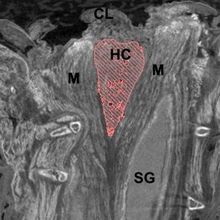reproduction

Snakes Have Clitorises After All, Study Finds
Natalia Mesa, PhD | Dec 13, 2022 | 4 min read
Researchers visualize the snake clitoris in detail for the first time, finding evidence that the organ may be evolutionarily important for snake sex.

Mammalian Oocytes Store mRNA in Newly Found Membraneless Structure
Alejandra Manjarrez, PhD | Oct 20, 2022 | 3 min read
The findings answer the longstanding question of where these cells hold the mRNA needed to cope with the transcriptional halt preceding meiosis.

Science Snapshot: Go Forth and Multiply
Lisa Winter | Oct 6, 2022 | 1 min read
An honorable mention in the 2022 Nikon Small World in Motion competition shows thale cress sperm being released into the ovule.

Secret to Reproductive Ants’ Longevity Revealed
Patience Asanga | Sep 2, 2022 | 3 min read
Researchers say they've figured out how some reproductive ants live up to 30 years—far longer than workers.

How Immature Egg Cells in Ovaries Resist Aging
Shafaq Zia | Aug 4, 2022 | 3 min read
The cells’ mitochondria skip a key metabolic reaction that takes place in other cells in the body, a study finds.

Trees’ Scent Tricks Hornets Into Shuttling Seeds
Natalia Mesa, PhD | Jun 30, 2022 | 4 min read
Agarwood fruit smells like prey, luring carnivorous hornets, a study suggests.

Opinion: The Reproductive Technology Advances No One Asked For
John D. Loike and Alan Kadish | Jun 22, 2022 | 4 min read
Cloning and parthenogenesis of humans wouldn’t align with bioethical principles.

Steroids May Explain Octopuses’ Self-Starvation
Andy Carstens | May 16, 2022 | 2 min read
Two glands increase steroid production after female California two-spot octopuses mate, a study finds. Those hormones may be responsible for the animals’ self-destructive behavior.

The Mystery of the Mouse Sperm Hook
Natalia Mesa, PhD | May 2, 2022 | 5 min read
Nearly all mouse sperm have hooks on their heads. But new research suggests the structures slow them down—so what exactly is their purpose?

Spiders Catapult Themselves to Avoid Becoming Their Mate’s Meal
Hannah Thomasy, PhD | Apr 25, 2022 | 2 min read
During their escape, male spiders can reach speeds in excess of 3 kilometers per hour thanks to their springy front legs.

Rat Sperm Generated from Stem Cells
Alejandra Manjarrez, PhD | Apr 7, 2022 | 4 min read
Researchers report they were able to make functional sperm in a dish, a feat previously only possible for mice.

The Scientist Speaks - DIY Cells: Understanding Life with a Synthetic Minimal Cell
Sejal Davla, PhD | Feb 25, 2022 | 1 min read
John Glass describes why researchers constructed a synthetic unicellular organism and how it unravels the secrets of evolution.

Could Dad’s Mitochondrial DNA Benefit Hybrids?
Alejandra Manjarrez, PhD | Jan 20, 2022 | 7 min read
Studies have found that organisms can inherit mitochondria from male parents in rare instances, and both theoretical and experimental work hint that this biparental inheritance is more than just a fluke.

The Scientist Editors’ Favorite Stories of 2021
The Scientist Staff | Dec 28, 2021 | 5 min read
A look back at some of the articles we most enjoyed reading, writing, and editing this year

“Xenobot” Living Robots Can Reproduce
Chloe Tenn | Dec 2, 2021 | 2 min read
Biological robots made from frog cells can replicate by smooshing loose cells into new robots—a reproduction method not seen in any other organism.

Infographic: Research Questions to Be Tackled by Uterus Transplants
Jef Akst | Aug 1, 2021 | 2 min read
Scientists are banking various samples from recipients of donated uteruses to learn all they can about the biology of the organ, and about transplantation more generally.

Uterus Transplants Hit the Clinic
Jef Akst | Aug 1, 2021 | 10+ min read
With human research trials resulting in dozens of successful deliveries in the US and abroad, doctors move toward offering the surgery clinically, while working to learn all they can about uterine and transplant biology from the still-rare procedure.

Opinion: How Biomedicine Could Transform Human Reproduction
Henry T. Greely | Aug 1, 2021 | 3 min read
CRISPR and other innovations are likely to open up a wealth of new options for how people have children.

Study that Impregnated Male Rats Stirs Controversy
Andy Tay | Jun 25, 2021 | 7 min read
A combination of approaches, including uterus transplantation and the joining of two animals’ circulatory systems, allowed males to bear pups, according to a preprint. But some experts say the experiments were not justified.
